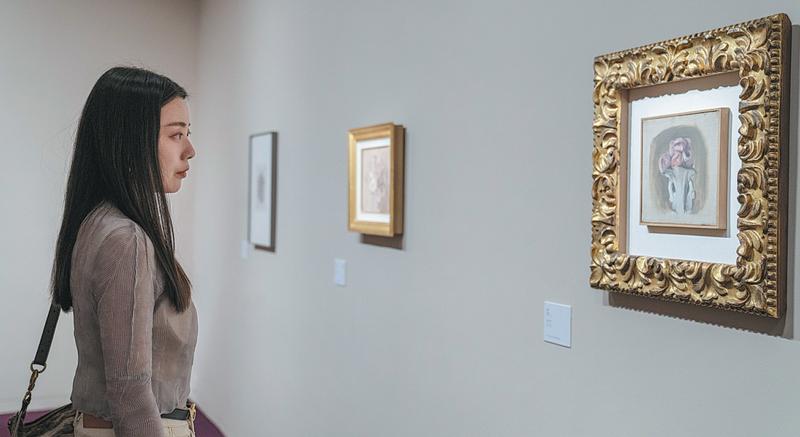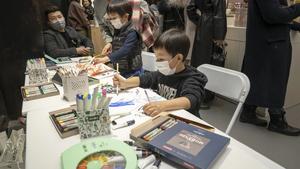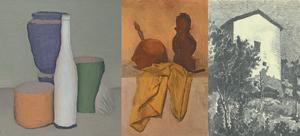Giorgio Morandi's works are being showcased in Beijing, Xu Haoyu reports.
 The ongoing exhibition in Beijing's M Woods art museum presents diverse works by Italian artist Giorgio Morandi and shows the changing styles in his decadeslong career. (PHOTO PROVIDED TO CHINA DAILY)
The ongoing exhibition in Beijing's M Woods art museum presents diverse works by Italian artist Giorgio Morandi and shows the changing styles in his decadeslong career. (PHOTO PROVIDED TO CHINA DAILY)
The Italian artist Giorgio Morandi (1890-1964) is not a complete stranger to Chinese people. His strong art style involving gray shades has been widely applied in decoration, fashion and many other fields. However, less is known about his life experience and career path. Like many artists, he is popularly referred to by his last name.
M Woods, an art museum in Beijing, is currently presenting around 80 Morandi's works, which are gathered from four countries, exploring six decades of his career.
Morandi and his art help us to relearn how to look at things we’ve ignored, and the objects we believed to be insignificant
Wang Zongfu, curator of the exhibition Giorgio Morandi: The Poetics of Stillness
The exhibition, titled Giorgio Morandi: The Poetics of Stillness, which runs through April 5, is the first solo show for the artist in China, highlighting his diverse works and change of art styles.
Morandi was born in Bologna, a city in central Italy, which is surrounded by medieval towers and shady loggias.
As a teenager, Morandi was passionate about art. At the age of 17, he studied painting at the Academy of Fine Arts of Bologna, one of the oldest art academies in the world.
From 1914 to 1929, he taught painting in a primary school in Bologna. This was interrupted by World War I. In 1915, he was drafted into the Italian army but was soon sent home due to illness and depression. In 1930, at the age of 40, he went back to the Academy of Fine Arts of Bologna and taught etching there until 1956.
Morandi's etchings are probably "his most underrated achievement", says Wang Zongfu, curator of the Beijing exhibition.
The artist created more than 130 etchings, which took up an important part of his career.
He lived like an ascetic-with no wife or offspring-and spent time working in his studio in the apartment which he shared with his three sisters. He visited different cities to attend his own exhibitions. He also traveled to Zurich, Switzerland, for French artist Paul Cezanne's exhibition.
 The museum is also hosting a workshop for children to display their talent. (PHOTO PROVIDED TO CHINA DAILY)
The museum is also hosting a workshop for children to display their talent. (PHOTO PROVIDED TO CHINA DAILY)
Throughout his life, Morandi painted bottles and captured the landscape of his hometown. He created 1,264 oil paintings alone, and this number does not include other forms such as drawings, watercolor works and etchings.
"Morandi and his art help us to relearn how to look at things we've ignored, and the objects we believed to be insignificant," Wang says. "But they are quite important to us."
The Beijing exhibition is reviewing Morandi's life path through four main sections, according to different focuses of his art: transitions, recurrence, landscapes and late works on paper.
The first section reveals the development of his visual language and innovation of themes, colors and composition.
Paintings on display include several representative works such as Still Life (1914), one of his earliest still-life paintings, and Still Life with Bottle and Jug (1915). The pieces challenge people's inherent cognition of ordinary things as the artist was strongly influenced by avant-garde movements such as cubism and futurism.
During the period when Morandi was working in a primary school, he explored metaphysics. Another of his famous works, Still Life (1928)-an upturned pot standing on a table and a 19th-century arc-shaped clock-shows only form and appearance of the objects.
Morandi once said: "The feelings and images that the visible world awakens in us are very difficult to express or are perhaps inexpressible with words, because they are determined by forms, colors, space and light."
The key to Morandi's artistic creation is to make repeated observations of the same set of objects and capture the inner essence of his paintings and etchings. His pattern of creating art is highlighted in the second section of the exhibition, traced through the evolution of two specific objects-a white bottle and a cylindrical white vase as seen in his later works such as Still Life (1956).
 Highlights of Morandi's solo show in Beijing include (from left) Still Life (1960), Still Life (1914) and Landscape (1927). (PHOTO PROVIDED TO CHINA DAILY)
Highlights of Morandi's solo show in Beijing include (from left) Still Life (1960), Still Life (1914) and Landscape (1927). (PHOTO PROVIDED TO CHINA DAILY)
The landscape section of the show has paintings, drawings and etchings, immortalizing the natural scenery of Grizzana, a town at the foothills of the northern Apennines, where Morandi stayed every summer from 1927 to 1932. At the same time, he didn't forget to paint the scenery outside the window of his studio in Bologna.
In addition, the section shows Morandi's passion for flowers in still life, with works created in the 1920s to 1950s, such as Flowers (1952).
In his later years, Morandi's works became more "open and wild", Wang says. At some point, the outline of an object in his drawings gradually disintegrated under his pencil, showing almost abstract lines and color blocks like some kind of undefinable existence.
The last section of the exhibition, presenting some of Morandi's drawings and watercolors created in the last 20 years of his life, shows this important transformation.
Some visitors say the exhibition has "shortened the distance "between them and the artist.
Huang Jiajun, 33, traveled from Shanghai to Beijing for the exhibition. He says he first heard about Morandi when the Chinese TV series The Story of Yanxi Palace became a hit in 2018. The producer of the drama chose gray as the main color for the costumes of actors and actresses.
"The drama can be easily separated from other period dramas, and its unique color tone makes it look elegant and luxurious at the same time, "Huang says, adding that he even painted the walls of his house in "Morandi's style of gray".
"I didn't know much about the artist before, but now I'm more than happy to learn when the chance comes."
Lin Yijia, 26, from Beijing, says: "I used to consider Morandi just a master of still life with a peaceful mind, but the exhibition has shown me more-the avant-garde trends he caught, the repeated portrayal of bottles, the scenery he enjoyed … I feel like I know him much better."
The Morandi family sent a letter to M Woods museum for the show.
"To China, Morandi is playing the role of Marco Polo in the 21st century. But this time, it's his art traveling to the East from the West… Morandi's artistic achievements truly connect the East and the West and unite the two together with shared values such as respect for the environment, responsibility, unity, creativity and innovation."
Contact the writer at xuhaoyu@chinadaily.com.cn


